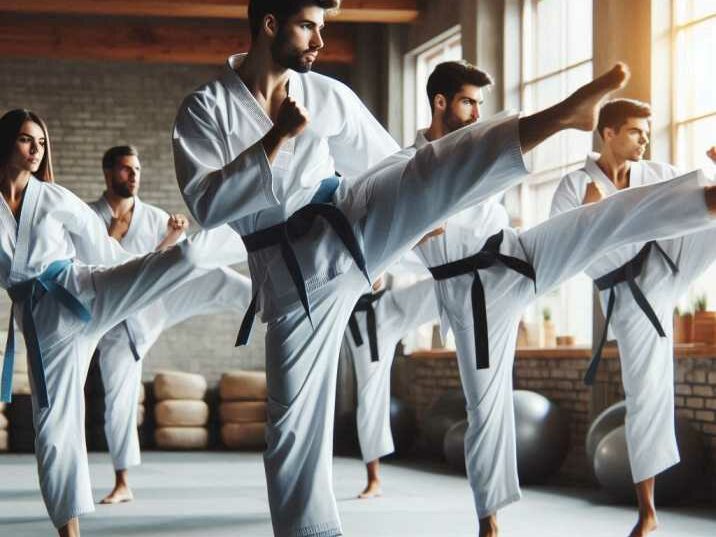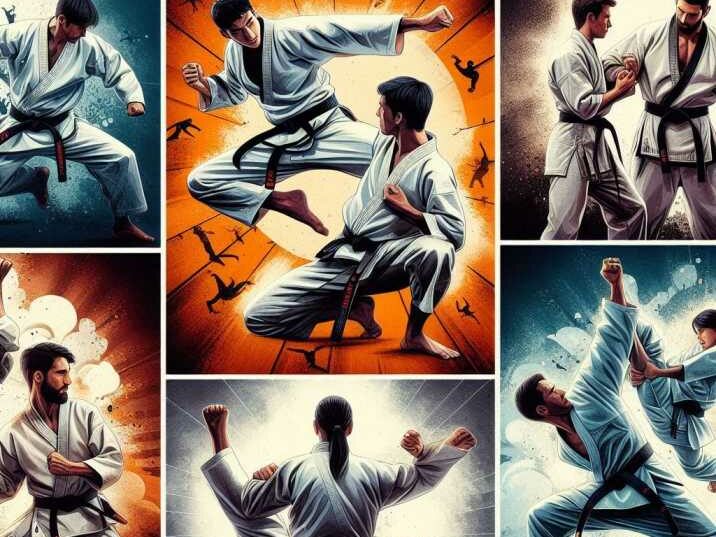Introduction
Table of Contents
When people talk about martial arts, they’re referring to a broad category of combat practices that include many different styles and techniques. One specific style within this category is Taekwondo. But what makes Taekwondo different from other martial arts? This article will explore the key differences between martial arts in general and Taekwondo, making it easy for you to understand even if you’re new to the world of martial arts.

Table of Contents
- What Are Martial Arts?
- What Is Taekwondo?
- Key Differences Between Martial Arts and Taekwondo
- 3.1 History and Origin
- 3.2 Techniques and Skills
- 3.3 Training and Practice
- 3.4 Philosophy and Goals
- 3.5 Competitive Aspects
- Benefits of Taekwondo vs. General Martial Arts
- Conclusion
- FAQs
What Are Martial Arts?
Martial arts encompass a wide range of combat practices that originate from various cultures around the world. They involve different techniques and philosophies, each offering unique methods for self-defense, personal development, and physical fitness. Here’s an overview of some of the most well-known martial arts:
Karate
- Origin: Japan
- Focus: Striking techniques
- Description: Karate is a martial art that emphasizes powerful strikes using the hands and feet. Practitioners, known as karatekas, learn to execute precise punches, kicks, knee strikes, and elbow strikes. The art also involves practicing katas, which are predetermined forms or patterns of movements that help practitioners refine their techniques and improve their coordination. Karate is often practiced both for self-defense and as a competitive sport, with tournaments featuring point-based sparring where competitors score points for controlled strikes.
Judo
- Origin: Japan
- Focus: Throws and grappling
- Description: Judo is a martial art that focuses on throws and grappling techniques. The goal in Judo is to use an opponent’s force and balance against them, rather than relying on brute strength. Practitioners, known as judokas, learn techniques such as hip throws and sacrifice throws, as well as various grappling techniques to control or submit an opponent. Judo emphasizes the principles of maximum efficiency and mutual welfare, and it is also an Olympic sport with competitions that reward points for successful throws and holds.
Kung Fu
- Origin: China
- Focus: Diverse techniques and forms
- Description: Kung Fu is a broad term for Chinese martial arts and encompasses a wide variety of styles and techniques. Each style of Kung Fu may have its unique focus, such as striking, grappling, or weapon techniques. Kung Fu training often includes practicing forms (known as taolu), which are choreographed patterns of movements that help develop technique, balance, and internal energy. Styles of Kung Fu like Wing Chun and Shaolin are famous for their distinctive techniques and philosophical teachings.
Brazilian Jiu-Jitsu (BJJ)
- Origin: Brazil
- Focus: Ground fighting and submission holds
- Description: Brazilian Jiu-Jitsu is a martial art that specializes in ground fighting and submission grappling. It focuses on techniques that allow a smaller, weaker person to defend against and defeat a larger opponent by using leverage, technique, and submissions such as joint locks and chokes. BJJ practitioners spend a significant amount of time rolling (sparring) on the ground to improve their grappling skills and apply techniques in live scenarios. BJJ has gained widespread popularity due to its effectiveness in mixed martial arts (MMA) competitions.
Each martial art has its unique style, techniques, and history.
What Is Taekwondo?
Taekwondo is a Korean martial art renowned for its emphasis on high, fast kicks and agile footwork. It combines elements of Karate with traditional Korean fighting techniques to create a distinctive style. Here’s a closer look at what makes Taekwondo unique:
Kicking Techniques
- Focus: High, fast kicks
- Description: One of the most defining aspects of Taekwondo is its focus on kicking techniques. Taekwondo practitioners, known as taekwondoin, use their legs extensively, performing a variety of kicks that include:
- Front Kick (Ap Chagi): A straightforward kick delivered with the ball of the foot, aimed at the opponent’s midsection or head.
- Roundhouse Kick (Dollyo Chagi): A powerful kick where the practitioner rotates their body to strike with the top of the foot, targeting the opponent’s side.
- Side Kick (Yop Chagi): A kick delivered from the side, using the edge of the foot to strike. It is effective for breaking through defenses.
- Spinning Kick (Dwi Chagi): A kick that involves spinning the body before delivering the kick. It includes techniques like the Spinning Back Kick and Spinning Hook Kick, which add surprise and power to the attack.
- Jumping Kick (Twio Chagi): A kick performed while jumping, which can be a variation of the front or roundhouse kick. It adds height and impact to the kick.
Taekwondo kicks are known for their speed, precision, and power. They are used in both self-defense and competition settings. The emphasis on kicking helps practitioners develop strong legs, flexibility, and agility.
Forms (Poomsae)
- Focus: Structured patterns of movements
- Description: In Taekwondo, forms (known as Poomsae in Korean) are predefined sequences of movements that simulate combat against imaginary opponents. Each Poomsae consists of a series of stances, strikes, and kicks performed in a specific order. Practicing Poomsae helps practitioners:
- Improve Technique: By repeating movements, practitioners refine their technique and execution.
- Enhance Coordination: Performing Poomsae requires precise coordination of movement, breathing, and focus.
- Build Strength and Flexibility: The practice involves various stances and movements that strengthen muscles and increase flexibility.
- Develop Discipline: The structured nature of Poomsae training instills a sense of discipline and concentration.
Poomsae are often categorized into different levels or ranks, with more complex forms introduced as practitioners advance. In competitions, Poomsae performance is judged on accuracy, power, and flow.
Key Differences Between Martial Arts and Taekwondo
3.1 History and Origin
- Martial Arts:
- Origins: The term “martial arts” is a broad category that includes various fighting techniques and practices from different cultures and historical periods. Each martial art has its unique origin and development:
- Karate: Developed on the island of Okinawa, Japan. It was influenced by indigenous Okinawan fighting styles and Chinese martial arts.
- Kung Fu: Originated in China and encompasses a wide range of styles and techniques, each with its historical and cultural significance.
- Judo: Created in Japan by Jigoro Kano in the late 19th century, evolving from traditional Japanese jujutsu.
- Brazilian Jiu-Jitsu (BJJ): Developed in Brazil in the early 20th century, influenced by Japanese jujutsu and judo.
- Origins: The term “martial arts” is a broad category that includes various fighting techniques and practices from different cultures and historical periods. Each martial art has its unique origin and development:
- Taekwondo:
- Origin: Taekwondo originated in Korea in the mid-20th century. It was developed by combining traditional Korean martial arts (like Taekkyeon and Hwa Rang Do) with influences from Japanese Karate. The name “Taekwondo” translates to “the way of the foot and fist,” reflecting its focus on kicking and striking techniques.
3.2 Techniques and Skills
- Martial Arts:
- Variety of Techniques: Martial arts encompass a broad range of techniques, depending on the style:
- Judo: Focuses on throws, joint locks, and pinning techniques. The goal is to use an opponent’s force against them.
- Kung Fu: Includes a diverse set of techniques, from striking and kicking to complex forms and weaponry. Styles can be internal (focusing on energy and movement) or external (emphasizing physical strength and speed).
- Variety of Techniques: Martial arts encompass a broad range of techniques, depending on the style:
- Taekwondo:
- Emphasis: Taekwondo is known for its dynamic kicking techniques. Practitioners perform a wide range of kicks, including high, spinning, and jumping kicks. While hand techniques are also used, the primary focus is on powerful and precise leg movements.
3.3 Training and Practice
- Martial Arts:
- Training Methods: Different martial arts have varied training approaches:
- Karate: Involves practicing katas (predefined forms) and kihon (basic techniques) along with sparring (kumite).
- Brazilian Jiu-Jitsu: Emphasizes live sparring (rolling) and drilling techniques to improve ground fighting and submission skills.
- Training Methods: Different martial arts have varied training approaches:
- Taekwondo:
- Training Components: Training in Taekwondo includes:
- Kicking Drills: Practitioners repeatedly practice kicks to improve speed, accuracy, and power.
- Poomsae (Forms): Structured patterns of movements that help in mastering techniques and improving form.
- Sparring: Practitioners engage in controlled matches to apply techniques in real-time. They often use special equipment like paddles and kicking pads to enhance their skills.
- Training Components: Training in Taekwondo includes:
3.4 Philosophy and Goals
- Martial Arts:
- Diverse Philosophies: The philosophies behind martial arts can vary:
- Karate: Emphasizes personal development, self-discipline, and respect for others.
- Judo: Focuses on principles like maximum efficiency and mutual welfare.
- Diverse Philosophies: The philosophies behind martial arts can vary:
- Taekwondo:
- Core Values: Taekwondo promotes a philosophy centered on:
- Courtesy: Showing respect to others.
- Integrity: Being honest and fair.
- Perseverance: Persisting in the face of challenges.
- Self-Control: Managing one’s actions and emotions.
- Indomitable Spirit: Demonstrating resilience and determination.
- Core Values: Taekwondo promotes a philosophy centered on:
3.5 Competitive Aspects
- Martial Arts:
- Competition Formats: Different martial arts have various competitive formats:
- Karate: Competitions often involve point-based sparring and kata performances.
- Judo: Focuses on executing throws, pins, and submission holds during matches.
- Competition Formats: Different martial arts have various competitive formats:
- Taekwondo:
- Olympic Sport: Taekwondo competitions are known for their fast-paced, high-kicking action. Competitors score points for controlled and accurate strikes to specific areas of the opponent’s body. The sport is featured in the Olympics, highlighting its global appeal and competitive nature.

Benefits of Taekwondo vs. General Martial Arts
- Taekwondo Benefits:
- Flexibility: Regular practice of high kicks and dynamic movements enhances overall flexibility.
- Leg Strength: The emphasis on kicking techniques develops strong leg muscles.
- Agility: The focus on quick, precise movements improves overall agility and coordination.
- General Martial Arts Benefits:
- Diverse Skills: Practicing various martial arts provides a broader range of skills, including striking, grappling, and self-defense techniques.
- Comprehensive Training: Each martial art offers unique benefits, from the grappling skills of Brazilian Jiu-Jitsu to the precise striking techniques of Karate.
Conclusion
Understanding the difference between martial arts and Taekwondo helps you appreciate each practice’s unique aspects. While Taekwondo is a specific form of martial art with its own techniques and philosophy, martial arts encompass a wide range of fighting styles from different cultures and histories. Whether you choose to practice Taekwondo or explore other martial arts, you’ll find that each offers valuable skills and insights.
FAQs
- What is the main focus of Taekwondo?
- Taekwondo primarily focuses on high, fast kicks and dynamic footwork.
- How does Taekwondo differ from Karate?
- Taekwondo emphasizes kicking techniques more than Karate, which focuses on punches and hand techniques.
- Is Taekwondo good for self-defense?
- Yes, Taekwondo teaches effective self-defense techniques, particularly through kicking and striking.
- Can Taekwondo be practiced by all ages?
- Yes, Taekwondo can be practiced by people of all ages, from children to adults.
- What are the benefits of practicing Taekwondo?
- Benefits include improved flexibility, strength, discipline, and self-confidence.


